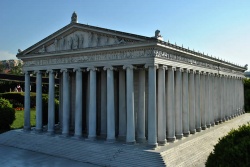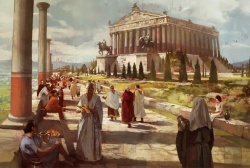
The Artemis Temple was built to renown Artemis, the Greek goddess of the hunt and the moon by Lydia’s King Croesus. This was designed and at the same time built by Architect Cherisiphron from Crete with help of Metagenes, his son.
Location of the Temple
The temple’s location in Asia Minor is near the commercial crossroads, this is why a wide range of different visitors are attracted to see the structure even though they vary when it comes to religious beliefs. The main reason, the cult of Artemis had also incorporated worship elements like Cybele, another deity. The temple at Ephesus also served as a marketplace as well as religious institution. It is being visited by a lot of tourists, merchants, kings and artisans that are paying tribute to the Goddess Artemis by sharing with her what they have like profits.
The Temple’s Impressive Design

- The design was not incorporated with a rectangle portico that is already common to the Greeks, but a fantastic mixture of designs coming from the Near-Eastern and the Classic Greek.
- The temple has a well-decorated façade that is overlooking a bright and broad courtyard.
- It has ionicly designed 127 columns with a height of 60 feet and at the sides of the column have circular carves.
- Unlike other temples in the world, the Artemission was a grand marble infrastructure, with a measure of 377 feet by 180 feet. The building’s platform is surrounded with steps, made also with marble.
- The columns are equipped with exquisite sculptural scenes rather than curving simple flutes. The exterior part of the temple is not just extraordinarily beautiful but also its interior part. Inside the Artemission are found the Amazon warriors sculptures that were created by the well-respected and marvellous Greek sculptors, Pheidias and Polyclitus.
- The walls are bounded with beautiful paintings and the columns of it were gilded with silver and gold. The temple houses a cult statue but not that large when compared with the statue of Zeus found at Olympia. It is more of a life-sized and is standing on a pedestal made of marble.
A Series of Destruction in the Temple
July 21, in the 356 BC, the temple was burned by Herostratus. He has nothing against the Ephesus temple or with the Artemis itself. He just saw the destruction as a possible way of having personal fame for his own good. After Alexander the Great’s death, the temple was put into reconstruction but was again the temple was destroyed by the Goths in 262 BC. Temple was rebuilt again by using the temple’s remain to restore at least the beauty of the building.
I have set eyes on the wall of lofty Babylon on which is a road for chariots, and the statue of Zeus by the Alpheus, and the hanging gardens, and the colossus of the Sun, and the huge labour of the high pyramids, and the vast tomb of Mausolus; but when I saw the house of Artemis that mounted to the clouds, those other marvels lost their brilliancy, and I said, "Lo, apart from Olympus, the Sun never looked on aught so grand"
The Artemission’s Remains

- Abundance
- Hunting
- Wild-life
During the devastating fire, the Artemis statue was removed. The statue is now exhibited and restored in the Ephesus Museum in Selcuk. The recently made archaeological excavations in the area also found and revealed some gifts that are coming from the pilgrims including earrings, necklaces and bracelets. There are also found artefacts coming from India and Persia.
The site of Ephesus, where the temple is located in Selcuk, only a few of reconstructed column are still standing in the area. These columns serve as a remembrance of the magnificent beauty of the temple, of why it is made as one of the Ancient World’s seven wonders.


